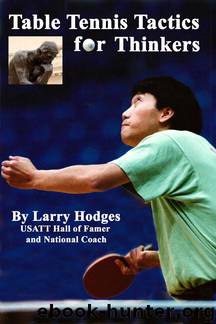Table Tennis Tactics for Thinkers by Larry Hodges

Author:Larry Hodges [Hodges, Larry]
Language: eng
Format: epub, azw3
Published: 2013-11-20T07:00:00+00:00
Flip Receive
USA Team Member Adam Hugh flips a short ball with his forehand. Photo by Diego Schaaf
A flip is how you attack a short ball. (In Europe, it's called a flick.) On the backhand side, often it's not much different than a normal backhand, though you normally shorten the stroke. (It's quite different if you use a banana or strawberry flip—see below!) On the forehand, it's quite different than a normal forehand, as you step in with your right foot (which would normally be back on normal forehands), and stroke the ball with forearm and sometimes wrist.
You should flip most topspin and sidespin serves, and probably most no-spin serves as well. It's a little trickier for most to flip backspin, but any short backspin serve can be flipped; learn to do so. Even if you won't flip backspin much, you want to establish it as a threat the server has to watch for, and you want to be ready to attack a backspin serve that pops up slightly.
You should flip with some topspin to control the shot. At the higher levels, players are now almost looping short balls, creating spin with their forearm and wrist snap, especially on the backhand side. Since it is easier to do this on the backhand side, many top players are now doing what many lower-level players have been doing for many years—often to the chagrin of coaches—which is to attack short serves to the forehand with their backhands. It would seem that doing this would take the receiver out of position, leaving him open on his backhand side, but if you move back quickly, it's not a major problem. Some of the best players get back so fast they can follow with a forehand from their backhand side. This is one of the biggest changes in recent years at the higher levels.
Most lower-level players who had done this before did so because they found it tricky to attack short balls with their forehand, especially against backhand sidespin type serves, where you have to aim to the right to compensate for the sidespin. At the higher levels, they do it because of the extra topspin they can create with the backhand over the table (compared to the forehand over the table), and also because it's also easier for them against backhand-type sidespin serves, just as it is for lower-level players. Many top players who receive backhand against short serves to the forehand only do so against this type of sidespin. (However, for players who use banana flips, it's often the opposite.)
Another advantage of the backhand receive against short serves to the forehand is that players are not used to it. Few things are more disconcerting to a server than having your short serve to the forehand flipped with a backhand to your own wide forehand! It's hard to guard against this shot since you also have to guard against the flip down the line to your backhand, and compared to the forehand flip, the backhand flip is easier to change directions at the last second.
Download
Table Tennis Tactics for Thinkers by Larry Hodges.azw3
This site does not store any files on its server. We only index and link to content provided by other sites. Please contact the content providers to delete copyright contents if any and email us, we'll remove relevant links or contents immediately.
The Inner Game of Tennis by W. Timothy Gallwey(3084)
Unstoppable: My Life So Far by Maria Sharapova(2178)
String Theory by David Foster Wallace(1210)
Zona by Geoff Dyer(1101)
Open: An Autobiography by Andre Agassi(1093)
You Cannot Be Serious by John McEnroe(1044)
Table Tennis Tactics for Thinkers by Larry Hodges(1041)
The Pub by Pete Brown(1005)
Game On by Monica Seles(981)
Rafa by Rafael Nadal & John Carlin(978)
On Tennis by David Foster Wallace(971)
Getting a Grip by Monica Seles(962)
Roger Federer by Chris Bowers(958)
Table Tennis Tips by Hodges Larry(901)
Everything You Know Is Pong by Roger Bennett(886)
Play Better Tennis in Two Hours by Oscar Wegner & Steven Ferry(877)
Ways of Grace by James Blake(861)
Days of Grace by Arthur Ashe(850)
Rod Laver by Rod Laver(826)
